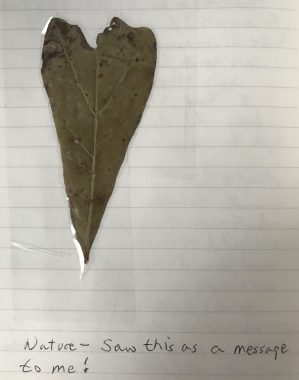Always Pay Attention to Your Body’s Signs
Recognizing symptoms and side effects is crucial with IPF, this columnist says

Shortly after I was diagnosed with idiopathic pulmonary fibrosis (IPF), I was on a walk and spotted a leaf in the shape of a heart. For some reason, the beauty of it struck me. It was a sign; nature had left me a message. I collected the leaf and taped it to a page in my journal.

Nature left me a sign. (Photo by Sam Kirton)
The number of signs around us can be incredibly overwhelming. Some are more important than others. Our brain parses the signs around us, categorizing them in an instant.
Every day we encounter regulatory, informational, and marketing signs. When we see a red octagon, we know a stop is ahead. On interstate highways, we understand that green rectangles contain helpful information. Finally, signs like “Eat at Joe’s” might trigger an unrecognized need, such as hunger.
Unfortunately, we often overlook or ignore signs regarding our health because our brains don’t recognize their importance.
Health signals
I’m the first to admit I didn’t recognize the signs of IPF that were right in front of me. The most apparent for me was a lingering cough. I’d been coughing for over a year, but attributed it to allergies. The second was my clubbed fingers. Although they were visible, I didn’t understand their significance. The other sign was only visible on a high-resolution computed tomography (HRCT) scan: patterns of fibrosis on my lungs.
In late 2016, my wife insisted I ask my primary care physician (PCP) if a chest X-ray was in order because of my lingering cough. That visit, along with the X-ray, marked the beginning of my IPF journey, though I wasn’t diagnosed for three more months.
My PCP ordered an HRCT scan and referred me to a pulmonologist for further evaluation. During that exam, the pulmonologist jumped off his stool, picking up my hands from where they’d been resting on my legs. He pressed my hands together, noting that I had clubbed fingers. I received a referral to Inova Fairfax Hospital’s Advanced Lung Disease and Transplant Center in Virginia before I left the exam room.
Recognizing the signs
A few years after my diagnosis, the Pulmonary Fibrosis Foundation and MoreThanACough.org created a campaign to increase awareness of the cough as a possible sign of PF. The first time I saw the campaign, I couldn’t help but wonder if being aware of this earlier would’ve made a difference in my journey.
Now, six years after my diagnosis, I seek to understand and recognize the signs associated with PF and transplant. Before my transplant, I paid close attention to changes in my pulmonary function test scores. I recognized increased shortness of breath and learned how to deal with that symptom.
Since my bilateral lung transplant in July 2021, I have learned to pay attention to different signs — ones that aren’t always immediately apparent. I now monitor trends to determine if there are any issues. Changes in my weight over three to five days or a 10% drop on my home spirometry test might be a sign of rejection. (A spirometry test measures how much air you inhale, how much you exhale, and how quickly you exhale.)
Many PF patients must also watch out for signs that their medications are causing side effects. For example, I recently had a new medication, Prograf (tacrolimus), added to my daily regimen. Kidney issues are a common side effect of Prograf, so in addition to blood tests ordered by my care team, I must be vigilant for signs that my kidneys are in distress.
To mitigate potential effects of Prograf on my kidneys, my care team added Rapamune (sirolimus) to my daily medication plan. Rapamune is a chemotherapy drug that may be used to preserve renal function. During my clinic visit, I made sure to ask about any signs or side effects I should watch for once I began these new medications.
Don’t ignore the signs
As you navigate your PF journey, I implore you to notice and heed your body’s signs. There’s nothing wrong with asking questions of your care team to ensure you understand which signs you should be looking out for; after all, you are your own best advocate. For me, it’s just another way I can make every breath count.
Note: Pulmonary Fibrosis News is strictly a news and information website about the disease. It does not provide medical advice, diagnosis, or treatment. This content is not intended to be a substitute for professional medical advice, diagnosis, or treatment. Always seek the advice of your physician or other qualified health provider with any questions you may have regarding a medical condition. Never disregard professional medical advice or delay in seeking it because of something you have read on this website. The opinions expressed in this column are not those of Pulmonary Fibrosis News or its parent company, Bionews, and are intended to spark discussion about issues pertaining to pulmonary fibrosis.









Karen Carns
Sam,
Another good article with important information. My hope is that many people see all the writings you are doing, which are all well written. Do you know what the distribution is for your articles?
Keep up the good work of helping others!
Karen
Samuel Kirton
Hi Karen and Jim,
As always thanks for reading my column and your comments. PF News is among the search results in Google. I encourage you to share it with family and friends who would benefit from learning more about PF.
Sam ...
Amanda Howle
Hi Sam,
Thank you for this article. It reaffirms my belief to be my own advocate with my health team. May you continue to inspire and encourage all of us living with this disease.
Regards
Amanda
Samuel Kirton
Hi Amanda,
Thanks for reading my column. I am glad you found this information useful. We, the patient community, are our own best advocates. Please stop back and let me know how you are doing on your journey.
Sam ...